 
 Main Menu
Main Menu
|
 Nevada Classics
Nevada Classics
|
 Advertise at CC
Advertise at CC
|
 November 2024
November 2024
|
| S |
M |
T |
W |
T |
F |
S |
| |
|
|
|
|
1 |
2 |
| 3 |
4 |
5 |
6 |
7 |
8 |
9 |
| 10 |
11 |
12 |
13 |
14 |
15 |
16 |
| 17 |
18 |
19 |
20 |
21 |
22 |
23 |
| 24 |
25 |
26 |
27 |
28 |
29 |
30 |
|
 CC Advertisers
CC Advertisers
|
|

07-18-2010, 01:37 PM
|
 |
CC Member

|
|
|
Join Date: Jul 2005
Location: Virginia Beach, Va & Port Charlotte, Fl.,
Posts: 2,284
|
|

 Not Ranked
Not Ranked
 Tired and frustrated with the glycol in oil leak..
Tired and frustrated with the glycol in oil leak..
Here's my tale of woe...  Any suggestions would be greatly appreciated.
I've been dealing with a small amount of coolant leakage into the oil of my Pond 482 for over a year now. Everything pointed to the Dove (typically porous) Tunnel Wedge intake. The engine originally had a Blue Thunder 427 MR 1x4 on it and it never leaked a drop with that combo. It started as soon as I swapped on the Tunnel Wedge. I ended up sending the Tunnel Wedge to Barry R for repair and he found a leak in it. He had some welding and re-machining done; a new pressure test then sent it back saying it was A-OK. I reinstalled it and had the same old problem, a milkshake in the valve covers. I tasted the froth, as I did in the first place and it had the sweet taste of glycol so I knew it wasn't simply condensation. It never leaked enough to taint the oil itself though. It to this day remains bright and clear. I added some Bars-Leaks block & intake sealer. It stopped the leak for several months but after that it started to return, gradually at first but eventually leaking as much as it did before I added the stop-leak. I finally decided to tear it down today as this leak was driving me nucking futs.
Here's a few pics of what I've done....
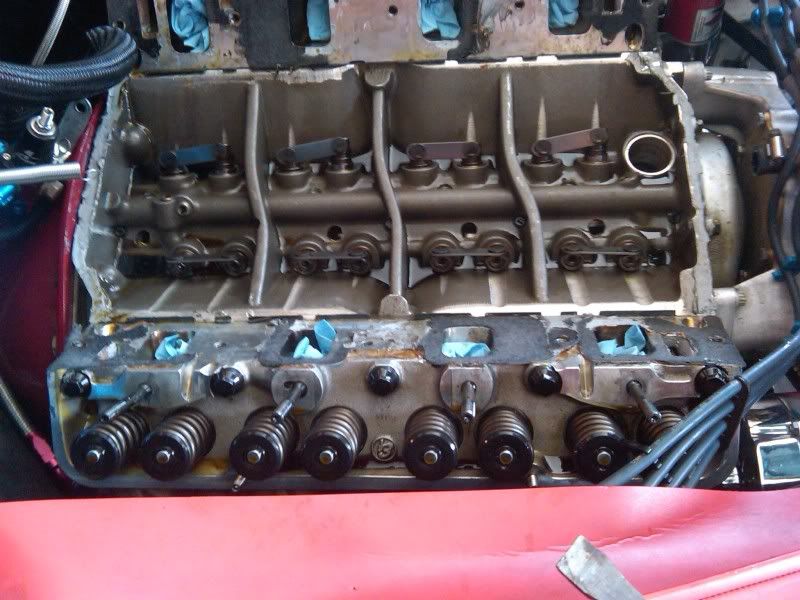
Here the top-o-the Pond with the intake off.
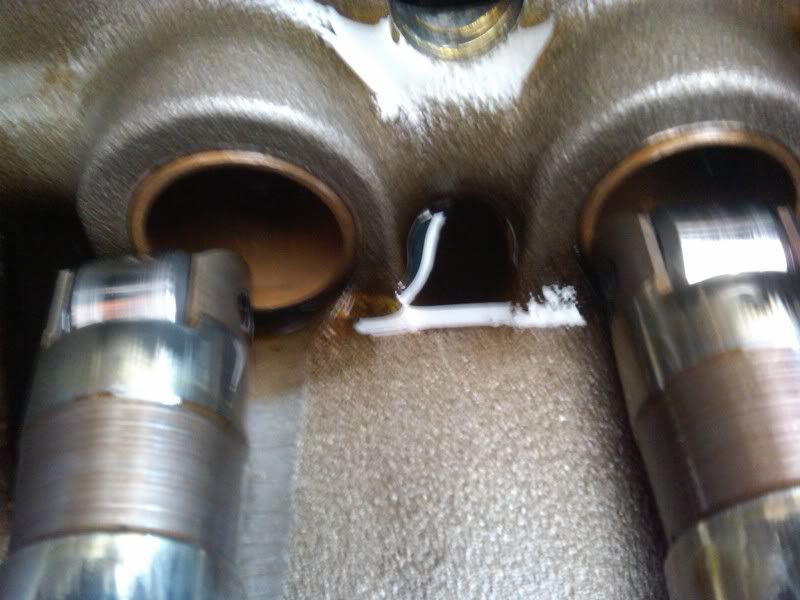
Here's the pretty silicone bronze thick walled lifter bushings.. The originally had the most beautiful Keith Craft cross-hatching.
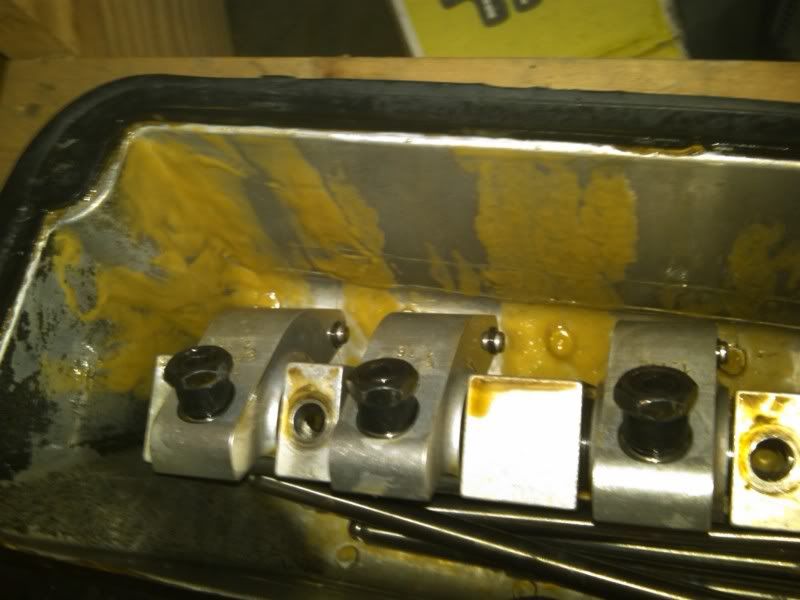
Here's the infamous valve cover milk shake. This is what originally alerted me to my problems.
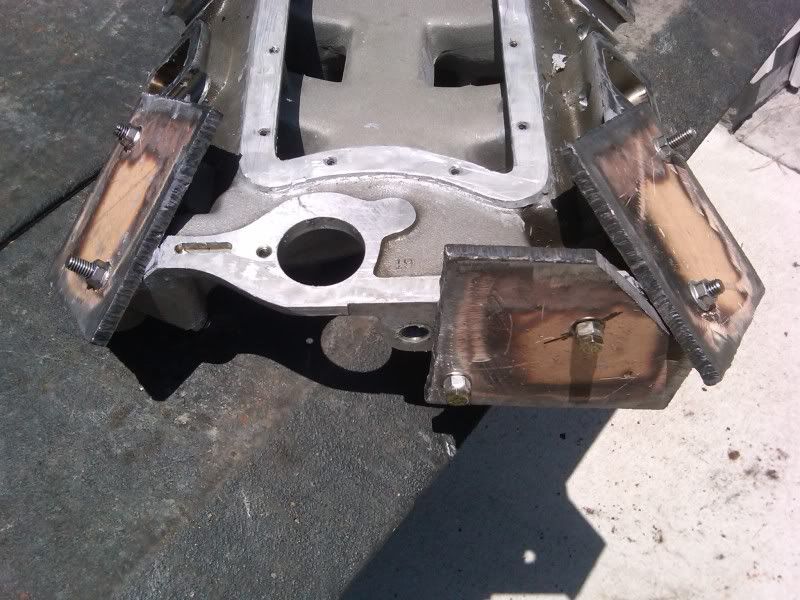
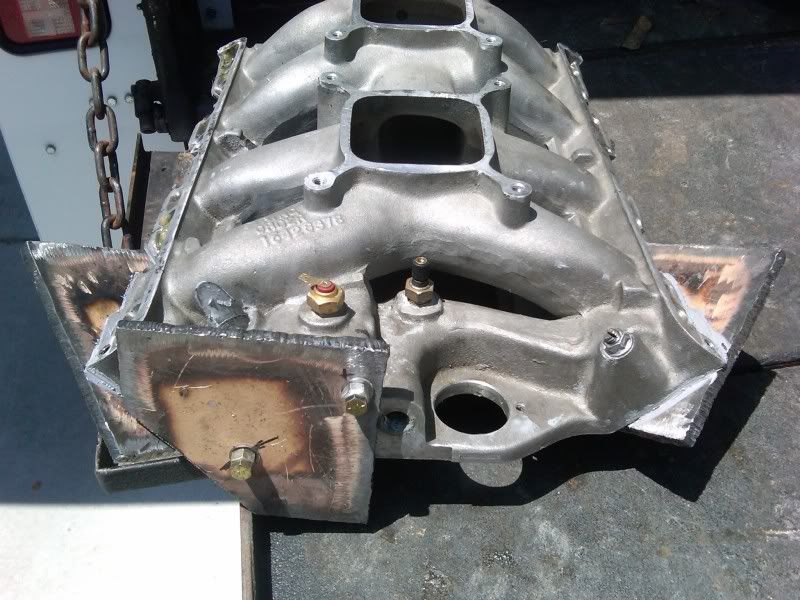
Here's my home made pressure "FE intake manifold pressure testing kit". It blanks both intake to head water outlets as well as the thermostat outlet. I pressure tested the intake with 100psi of Nitrogen and could not find one leak!! I'm at a loss now. Do I pre-heat the intake and test again?? Do I continue the tear-down and pull the heads for pressure testing?? The Block, pressure test it too?? Where does it all end? I never had a problem until I installed the Tunnel Wedge so my 6th sense tells me to fix the intake. I pulled it with the intent of sending it out for "Pressure casting Impregnation". That is what Dove recommended.
http://www.godfreywing.com/vacuum-casting-impregnation/
Thoughts people???
__________________
Too many toys?? never!
|
-
Advertising


07-18-2010, 01:48 PM
|
 |
CC Member

|
|
|
Join Date: Jul 2005
Location: Bartlett,
Ill
Cobra Make, Engine: Everett-Morrison LS1
Posts: 2,448
|
|

 Not Ranked
Not Ranked
What temp do you run your oil at????I have seen several cases of the milkshake that was just combustion by product blowby that condensed in the ribbed valve covers---change the valve covers and run the oil hotter with more ventilation--- you might find it advantagious to run a tube to a whisle in the exhaust header that will provide suction that the pcv won't do at wot. |

07-18-2010, 02:57 PM
|
|
CC Member

|
|
|
Join Date: Oct 2003
Posts: 4,078
|
|

 Not Ranked
Not Ranked
I would clean up the mating faces of intake and heads, then place the intake back on with just a few fasteners hand tight and no gaskets . Then measure the intake to head mating gaps both front and rear with feelers as well as the China rails. Possibly KC did not machine the intake to match the head angle. Doves are NOT perfect-but you know that already...
Pushrod alignment should be checked too. I went through this with my Dove TW long ago. If you find slant in the surfaces, give Barry the numbers and he will true the intake for you.
__________________
Chas.
|

07-18-2010, 04:27 PM
|
 |
CC Member

|
|
|
Join Date: Jul 2005
Location: Virginia Beach, Va & Port Charlotte, Fl.,
Posts: 2,284
|
|

 Not Ranked
Not Ranked

Quote:
Originally Posted by Jerry Clayton

What temp do you run your oil at????I have seen several cases of the milkshake that was just combustion by product blowby that condensed in the ribbed valve covers---change the valve covers and run the oil hotter with more ventilation--- you might find it advantagious to run a tube to a whisle in the exhaust header that will provide suction that the pcv won't do at wot. |
Doesn't matter, condensation in the oil does NOT taste like glycol. The taste is so strong I don't even have to send a sample out to the lab to confirm. 190 to 210 on the oil temps. Actually... the hotter the engine/oil runs (higher coolant system pressures/temperatures too) the more "milk shake" I get. 
My ventilation is so good that my rear seal doesn't even leak.  I've 2 breathers AND a PCV.
Quote:
Originally Posted by ERA Chas

I would clean up the mating faces of intake and heads, then place the intake back on with just a few fasteners hand tight and no gaskets . Then measure the intake to head mating gaps both front and rear with feelers as well as the China rails. Possibly KC did not machine the intake to match the head angle. Doves are NOT perfect-but you know that already...
Pushrod alignment should be checked too. I went through this with my Dove TW long ago. If you find slant in the surfaces, give Barry the numbers and he will true the intake for you.
|
I checked all gaps with a feeler every time I assemble. The last time I put it together everything was perfect. The gasket witness marking and crush depth was perfect. I paid particular attention to it when I pulled it apart today. This is the second go-round with this. Both times the intake gaskets had a perfect seal.
Barry has already cut the intake and clearanced the pushrod holes. Once torqued down the intake/head port alignment is perfecto. That's the major reason I don't scrap the intake and get a new one, just too much $$ and time in the intake.
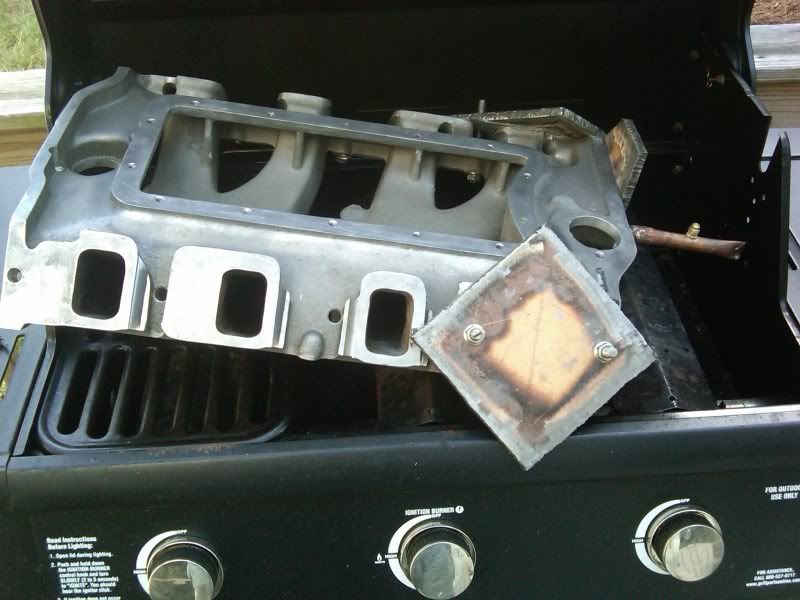
Thinking I needed to pre-heat the manifold to duplicate engine temps and thus cause it to expand and start leaking I preheated it to 250 deg. Necessity is the mother of invention, don't you know. I used one of my infrared laser heat guns to verify manifold temps.

I jumped to pressure up to 150 psi @ 250 deg and STILL NO LEAK. I am bummed.. 
I guess it's time to talk to some builders to help figure this out. It really could turn into a witch hunt, which I really don't have the time for right now.
__________________
Too many toys?? never!
|

07-18-2010, 05:16 PM
|
|
Club Cobra Member

|
|
|
Join Date: Jul 2002
Location: Huntington Beach, CA,
CA
Cobra Make, Engine: Kirkham 482 ci alum block
Posts: 250
|
|

 Not Ranked
Not Ranked
We have impregnated aluminum castings before with great success, but your passes the leak test.
|

07-18-2010, 06:31 PM
|
|
CC Member

|
|
|
Join Date: Oct 2003
Posts: 4,078
|
|

 Not Ranked
Not Ranked
Quote:
Originally Posted by undy

I guess it's time to talk to some builders to help figure this out. It really could turn into a witch hunt, which I really don't have the time for right now.
|
Dude, you get an 'A' for thoroughness.
My last gasp at this one is the gaskets although those look like my Victor Nitro-Seals (which helped cure my problem).
Barry now uses MLS FelPros which he probably helped design- the key being the layers. The standard FelPros have no lasting integrity in street use with green coolant. You using green stuff?
__________________
Chas.
|

07-18-2010, 07:31 PM
|
|
CC Member

|
|
|
Join Date: Jun 2005
Cobra Make, Engine:
Posts: 3,077
|
|

 Not Ranked
Not Ranked
You stupid sheet. You are lucky to be alive. WTF, you are creating a grenade with those type of pressures. Cast aluminuim to boot.
|

07-18-2010, 07:40 PM
|
|
CC Member

|
|
|
Join Date: May 2006
Location: St. Louisville,
Oh
Cobra Make, Engine: A&C 67 427 cobra SB
Posts: 2,445
|
|

 Not Ranked
Not Ranked
Dear Nucking Futs,
You have fallen to the old magicians trick. You have been focused on the left hand and did not see what the right hand was doing.
The intake is no longer the problem, but you were zeroed in on it like a hawk on a mouse.
Are the two valve covers identical in the milk shake? If one is worse, I suspect that head is leaking up into the valve cover area. If they are identical, I would suspect that a head gasket is leaking into the oil area some where. Is there any indication (milk shake) in the lifter gallery.
Also be careful with the nitrogen. One lung full and your dead.
Last edited by olddog; 07-18-2010 at 09:22 PM..
|

07-18-2010, 08:17 PM
|
|
CC Member

|
|
|
Join Date: Dec 2004
Location: toronto,
ont
Cobra Make, Engine: 408w 500 h.p. 550 ft.lbs
Posts: 562
|
|

 Not Ranked
Not Ranked
Just out of curiosity, what procedure are you using with the nitrogen pressure test?
EG.--apply pressure, close the supply valve, observe the pressure Gauge over a period of time.
I have had good results with water rather than a gas. Using a gas will not indicate a small leak as readily because it is compressible whereas water is not & will show a minute loss immediately.
The other benefit is the water is visible--even 1 drop.
Craig
|

07-18-2010, 08:30 PM
|
 |
CC Member

|
|
|
Join Date: May 2009
Location: American Fork,
Ut
Cobra Make, Engine: 66 Cobra
Posts: 930
|
|

 Not Ranked
Not Ranked
I agree with Olddog. Since you didn't say anthing about white smoke coming out the exhaust I would be looking now for a leak from a gasket first and next a crack. A crack could be anywhere in the engine but be evidenced by the milky susbstance in valve covers. As the coolant heats up and turns to steam it rises and you can usually see it in the valve covers. When you pulled the intake what did the gaskets look like. It's all evidence to finding the problem. Look for the small tell tale signs. You may have to pull the heads and go further.
Last edited by Wbulk; 07-18-2010 at 09:14 PM..
Reason: Correction
|

07-18-2010, 09:02 PM
|
|
CC Member

|
|
|
Join Date: May 2006
Location: St. Louisville,
Oh
Cobra Make, Engine: A&C 67 427 cobra SB
Posts: 2,445
|
|

 Not Ranked
Not Ranked
Quote:
Originally Posted by cdnus

Just out of curiosity, what procedure are you using with the nitrogen pressure test?
EG.--apply pressure, close the supply valve, observe the pressure Gauge over a period of time.
I have had good results with water rather than a gas. Using a gas will not indicate a small leak as readily because it is compressible whereas water is not & will show a minute loss immediately.
The other benefit is the water is visible--even 1 drop.
Craig
|
Interesting point, however gas molecules are much smaller than liquid molecules. Therefore a gas may pass through a tiny crack that a liquid cannot. It just takes more time for the gas pressure to drop. |

07-18-2010, 09:04 PM
|
|
CC Member

|
|
|
Join Date: Feb 2008
Location: Jacksonville,
FL
Cobra Make, Engine: Kirkham #570 w Shelby FE
Posts: 1,009
|
|

 Not Ranked
Not Ranked
Perhaps it's not the front passages...
Even though they don't go anywhere, don't forget the two coolant ports in the back. (jamming a modded freeze plug in those back ports or epoxying (JB weld) them off wouldn't hurt)
On re-assembly, give the intake gaskets a good coat of "high tack". (the nasty red stuff from permatex) Make sure you let this stuff set up a day or two before putting coolant back in.
http://www.permatex.com/products/Aut...et_Sealant.htm
Have you checked the entire intake face with a straight edge to verify there is no warping? As asked previously, both covers?
Also some coolant dye might help here.
Last edited by Ronbo; 07-18-2010 at 09:15 PM..
|

07-18-2010, 09:06 PM
|
|
CC Member

|
|
|
Join Date: Dec 2004
Location: Kansas City,
KS
Cobra Make, Engine: jbl
Posts: 2,291
|
|

 Not Ranked
Not Ranked

it's weird that it started when you replaced the intake, then discovered the intake had issues and fixed that, yet it continues.
can you replace all the parts without gaskets and determine if the angle or clearance between parts is acceptable?
if everything looks good here and things are installed properly you will have to look elsewhere.
next time you get everything together, and i guess you have changed the oil a couple times, and after eliminating all other possibilities, i would put some pressure into the cooling system with coolant installed of course, and if you can drop the oil pan i would look at the bottom of the cylinders where the liners meet the block and see if there are any leaks.
just a thought, don't know if this is a possibility, or maybe you will be able to see if there is a leak coming from somewhere else, or at a minumum you will be able to tell if it is holding. of course if this is happening only when hot, that complicates things, but aluminum does expand quite a bit more then the steel liners.

|

07-18-2010, 09:21 PM
|
 |
CC Member

|
|
|
Join Date: May 2009
Location: American Fork,
Ut
Cobra Make, Engine: 66 Cobra
Posts: 930
|
|

 Not Ranked
Not Ranked
Looking at the picture of the valley the oil looks normal. I believe this leak is very, very small, and is turning to steam before it can run down to get into the oil. If it were a larger leak you would have milky engine oil, but you don't.
|

07-18-2010, 09:45 PM
|
|
CC Member

|
|
|
Join Date: May 2006
Location: St. Louisville,
Oh
Cobra Make, Engine: A&C 67 427 cobra SB
Posts: 2,445
|
|

 Not Ranked
Not Ranked

Since I never had an FE apart myself, I been studying these pictures and the sequence of events that you described. The oil drain back holes at the four corners of the heads is very close to the water ports. Also one of the intake bolts is close to that area. If there is a crack in that area, torquing the intake bolts might aggravate it. Look hard it that area.
Pull the water pump. Block off the water pump ports and the head ports, and pressure test at a reasonable pressure. I would think 25 psi would be enough. I bet I doesn't hold.
CDNUS has an excellent point on water can be seen. You could fill it up with water and then pressurize it with the bottle. You might see it that way if the leak is up top.
If it is the head gasket leaking into the oil that flows up to the rockers, it could only leak water in when the oil pressure is less than the water pressure. Like when the engine is off. Therefore it makes sense that at high rpm (high oil pressure) it is pumping oil into the water. Check the water for oil.

|

07-19-2010, 01:45 AM
|
|
CC Member

|
|
|
Join Date: Mar 2001
Location: E BRUNSWICK N.J. USA,
Posts: 3,841
|
|

 Not Ranked
Not Ranked
 Major crack in picture #4??
Major crack in picture #4??
Undy Dave it's 3:37am. Back hurts bad. Is that a crack in picture #4 between the opening to the water jacket of the manifold? The other thing is what is the slot for going to the edge of the manifold or bolt hole? That cracks looks bad and heading in the right direction.
My testing and looking at the cream in the motor is intake failure or gasket, small leak. You have the plates made for pressure testing. Big keddle with water and heat to about 190f. Watch for air bubbles. I think you will find them. Rick L.
|

07-19-2010, 06:48 AM
|
 |
CC Member

|
|
|
Join Date: Jul 2005
Location: Virginia Beach, Va & Port Charlotte, Fl.,
Posts: 2,284
|
|

 Not Ranked
Not Ranked

Quote:
Originally Posted by David Biele

We have impregnated aluminum castings before with great success, but your passes the leak test.
|
Regardless, I am still planning on sending the intake off for the impregnation. No stone will remain unturned...
Quote:
Originally Posted by ERA Chas

Dude, you get an 'A' for thoroughness.
My last gasp at this one is the gaskets although those look like my Victor Nitro-Seals (which helped cure my problem).
Barry now uses MLS FelPros which he probably helped design- the key being the layers. The standard FelPros have no lasting integrity in street use with green coolant. You using green stuff?
|
I'm using Keith's old paper intake gaskets that he had laser cut for his Ebok stage IIs. He's since contracted with Cometic to custom make the same gaskets. He said he moved to the Cometics due to gasket failures with the other style. I didn't ask any particulars, I will today though. That being said, I talked to Shelly @ KCR and have a set of cometics on the way. Even though the intake gaskets were crushed good and showed no signs of the infamous "Felpro gasket creep" I did notice that the gasket around the two coolant ports were sort of "mushy". I guess the coolant could have worked it's way between the paper layers to the oil side of the intake?? The Cometics, according to Keith, have a hard core. I really hate to yank the heads or the whole engine for that matter. 
I use the green coolant... Maybe Dexcool's in my future.
Quote:
Originally Posted by madmaxx

You stupid sheet. You are lucky to be alive. WTF, you are creating a grenade with those type of pressures. Cast aluminum to boot.
|
More drama than fact I'm afraid... I've been doing this stuff professionally for 40 years. Evidently you were snoozing during your engineering "Strengths of Materials" classes 
Quote:
Originally Posted by cdnus

Just out of curiosity, what procedure are you using with the nitrogen pressure test?
EG.--apply pressure, close the supply valve, observe the pressure Gauge over a period of time.
I have had good results with water rather than a gas. Using a gas will not indicate a small leak as readily because it is compressible whereas water is not & will show a minute loss immediately.
The other benefit is the water is visible--even 1 drop.
Craig
|
The intake gaskets started to lift/seep minutely around 60 psi so I kept the regulator set at a constant 100/150 psi to maintain pressure. I've got quite a variety of HVAC leak detection equipment (electronics and liquid) and it all failed to show any signs of leaks. BTW... the entire area that could possibly leak water into the oil is entirely visible so there's no mystery there.
A nitrogen molecule is much smaller than a water molecule. Trust me, nitrogen will show it before water does.
Quote:
Originally Posted by Wbulk

I agree with Olddog. Since you didn't say anything about white smoke coming out the exhaust I would be looking now for a leak from a gasket first and next a crack. A crack could be anywhere in the engine but be evidenced by the milky substance in valve covers. As the coolant heats up and turns to steam it rises and you can usually see it in the valve covers. When you pulled the intake what did the gaskets look like. It's all evidence to finding the problem. Look for the small tell tale signs. You may have to pull the heads and go further.
|
No smoke, nada... There's nothing entering the combustion chamber, just traces in the oil. I'm getting the froth in both valve covers, naturally more so in the valve cover where the PVC is (all vapor/air currents normally flow in the direction of the PCV).
I may well end up pulling the heads, next weekend's chore. The blank flanges I made for the intake pressure test will work on them too. The gaskets (both times I pulled the intake) looked fine, perfect in fact. As I said earlier I plan on talking to Keith as to why he abandoned the "old style" intake gaskets. That may be the answer to my dilemma (fingers crossed).
Quote:
Originally Posted by olddog

Interesting point, however gas molecules are much smaller than liquid molecules. Therefore a gas may pass through a tiny crack that a liquid cannot. It just takes more time for the gas pressure to drop.
|
True dat! 
Quote:
Originally Posted by Ronbo

Perhaps it's not the front passages...
Even though they don't go anywhere, don't forget the two coolant ports in the back. (jamming a modded freeze plug in those back ports or epoxying (JB weld) them off wouldn't hurt)
On re-assembly, give the intake gaskets a good coat of "high tack". (the nasty red stuff from permatex) Make sure you let this stuff set up a day or two before putting coolant back in.
http://www.permatex.com/products/Aut...et_Sealant.htm
Have you checked the entire intake face with a straight edge to verify there is no warping? As asked previously, both covers?
Also some coolant dye might help here. |
Interesting thought on the rear coolant passages. I'll look further into the possibility.
The intake's face is perfect on both sides. Gasket crush was uniform and just what it should be on both sides.
It's internal so coolant dye is useless, other than telling me I've a leak somewhere (which I already know...)
Quote:
Originally Posted by vector1

it's weird that it started when you replaced the intake, then discovered the intake had issues and fixed that, yet it continues.
can you replace all the parts without gaskets and determine if the angle or clearance between parts is acceptable?
if everything looks good here and things are installed properly you will have to look elsewhere.
next time you get everything together, and I guess you have changed the oil a couple times, and after eliminating all other possibilities, I would put some pressure into the cooling system with coolant installed of course, and if you can drop the oil pan I would look at the bottom of the cylinders where the liners meet the block and see if there are any leaks.
just a thought, don't know if this is a possibility, or maybe you will be able to see if there is a leak coming from somewhere else, or at a minimum you will be able to tell if it is holding. of course if this is happening only when hot, that complicates things, but aluminum does expand quite a bit more then the steel liners.
|
Trust me, all the possibilities scares the He!! out of me. I guess if I'm not convinced otherwise the heads are the next step... then the short block. 
Quote:
Originally Posted by Wbulk

Looking at the picture of the valley the oil looks normal. I believe this leak is very, very small, and is turning to steam before it can run down to get into the oil. If it were a larger leak you would have milky engine oil, but you don't.
|
That's all true... The leak is getting no larger, even from the first time it appeared over a year ago. That sure doesn't point to a gasket, more so a crack or porosity.
Quote:
Originally Posted by olddog

Dear Nucking Futs,
You have fallen to the old magicians trick. You have been focused on the left hand and did not see what the right hand was doing.
The intake is no longer the problem, but you were zeroed in on it like a hawk on a mouse.
Are the two valve covers identical in the milk shake? If one is worse, I suspect that head is leaking up into the valve cover area. If they are identical, I would suspect that a head gasket is leaking into the oil area some where. Is there any indication (milk shake) in the lifter gallery.
Also be careful with the nitrogen. One lung full and your dead.
|
That's what I'm afraid of... It just doesn't fit the mold for a gasket type leak. There's no signs of moisture present other than what's in the valve covers, the valley and top of the heads are milk shake free.
Most of the air we breath is composed of Nitrogen... Now my flagellant self.. that's a different story.   
Quote:
Originally Posted by olddog

Since I never had an FE apart myself, I been studying these pictures and the sequence of events that you described. The oil drain back holes at the four corners of the heads is very close to the water ports. Also one of the intake bolts is close to that area. If there is a crack in that area, torquing the intake bolts might aggravate it. Look hard it that area.
Pull the water pump. Block off the water pump ports and the head ports, and pressure test at a reasonable pressure. I would think 25 psi would be enough. I bet I doesn't hold.
CDNUS has an excellent point on water can be seen. You could fill it up with water and then pressurize it with the bottle. You might see it that way if the leak is up top.
If it is the head gasket leaking into the oil that flows up to the rockers, it could only leak water in when the oil pressure is less than the water pressure. Like when the engine is off. Therefore it makes sense that at high rpm (high oil pressure) it is pumping oil into the water. Check the water for oil.
|
I'm leaning more towards and entire engine pressure test, as you mention. There' been no oil in the coolant. I kept a close check on that.
Quote:
Originally Posted by RICK LAKE

Undy Dave it's 3:37am. Back hurts bad. Is that a crack in picture #4 between the opening to the water jacket of the manifold? The other thing is what is the slot for going to the edge of the manifold or bolt hole? That cracks looks bad and heading in the right direction.
My testing and looking at the cream in the motor is intake failure or gasket, small leak. You have the plates made for pressure testing. Big kettle with water and heat to about 190f. Watch for air bubbles. I think you will find them. Rick L.
|
Rick, Rick, Rick... You're getting old before your time. It's old fartz like me that's supposed to be messed up.. I hope you start feeling better bud. 
No crack, just some vagrant RTV. The slot goes no where. Anyway, it didn't leak during the pressure test.
The manifold was preheated to 240 deg uniformly and nothing was present at 150 psi. I don't think a kettle will do anything for me... other than cook dinner. 
__________________
Too many toys?? never!
|

07-19-2010, 07:00 AM
|
|
CC Member

|
|
|
Join Date: Dec 2004
Location: Kansas City,
KS
Cobra Make, Engine: jbl
Posts: 2,291
|
|

 Not Ranked
Not Ranked
since everything is aluminum and expands quite a bit, i would still look to sealing problems at the intake. if you've eliminated the possibility of the intake porosity problem, then........
next time you install the intake loosen the head bolts and install the intake and torque to spec or as close as possible, then torque the heads down. that should provide a good mating surface between the intake and heads.
|

07-19-2010, 07:21 AM
|
 |
CC Member

|
|
|
Join Date: Jul 2005
Location: Bartlett,
Ill
Cobra Make, Engine: Everett-Morrison LS1
Posts: 2,448
|
|

 Not Ranked
Not Ranked
I magnified #4 up to 1000% and it sure looks like a crack----
A comment about nitrogen and air being mostly nitrogen----we breathe because of a build up of carbon dioxide in our res systems----a lung full of nitrogen will cause no co2 and you won't breathe---just go to sleep
The slime will go away with proper/adequate ventilation of the engine---it could be building up because of your two breathers. not the correct balance of flow and also the engine can be sucking in outside vapor on cool down---the ribbed covers agrevate that condition (top of motor cools quicker than bottom, alum quicker than iron)
you are pretty upset at this and it shows in your responses--
have you been a taster of coolant for very many years???
|

07-19-2010, 07:27 AM
|
 |
CC Member

|
|
|
Join Date: Aug 2009
Location: Edinburg,
TX
Cobra Make, Engine: Everett Morrison, All aluminum small block ford.
Posts: 436
|
|

 Not Ranked
Not Ranked
I think its a head gasket. Running your oil at the temps your running at is burning the water out of the oil in the pan and the motor. The valve covers run quite a bit cooler and cool faster when you shut the motor down..hence the milk shake but not the creamy oil.
Are you loosing water? Something you might try if you have it back together and didnt fix the leak. Put a radiator pressure tester on the radiator. Pump it up to about 15 psi...fire it up and let it run for just a few minutes. Then check your oil and see if you have any coolant present. Need to check it before it has a chance to get hot enough to burn it off.
Just a thought.
__________________
" If it wont break em loose in 3rd gear, it aint enough power "
|
 Posting Rules
Posting Rules
|
You may not post new threads
You may not post replies
You may not post attachments
You may not edit your posts
HTML code is Off
|
|
|
All times are GMT -7. The time now is 06:01 PM.
|

















 Any suggestions would be greatly appreciated.
Any suggestions would be greatly appreciated.








 I've 2 breathers AND a PCV.
I've 2 breathers AND a PCV.




 Linear Mode
Linear Mode



